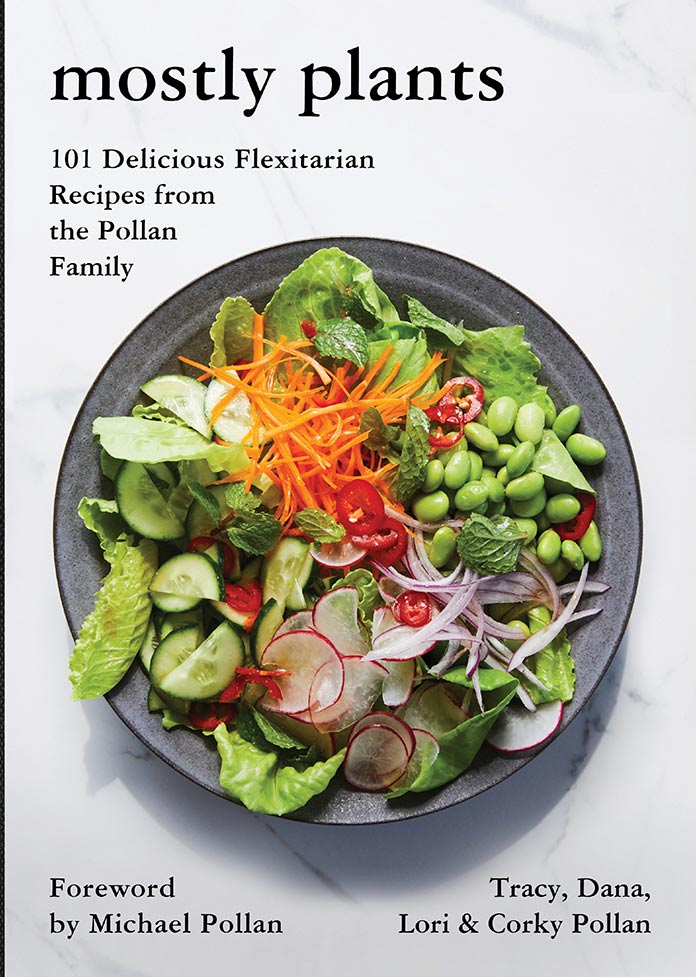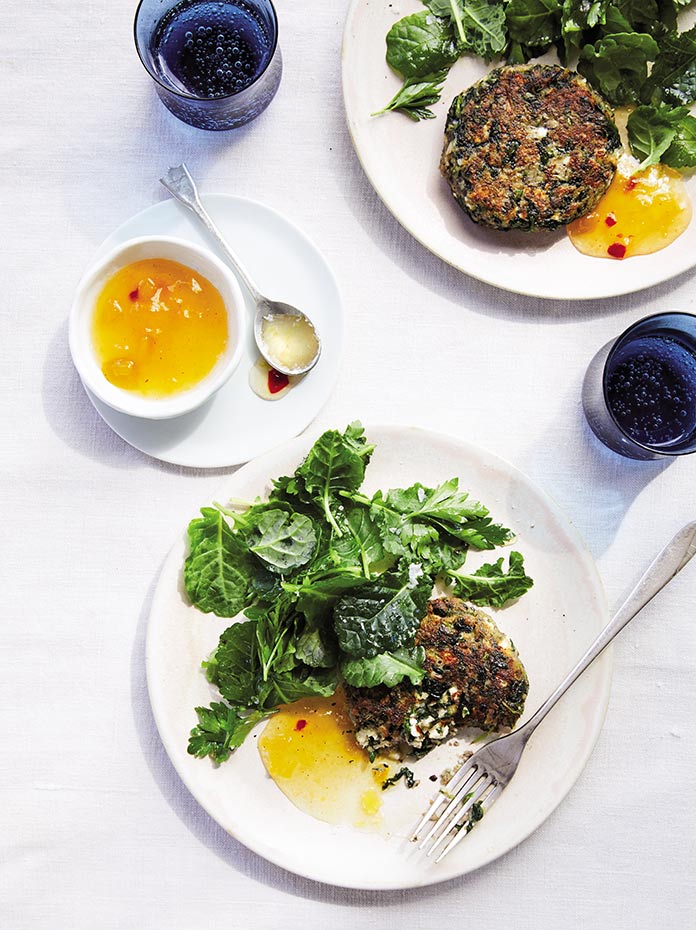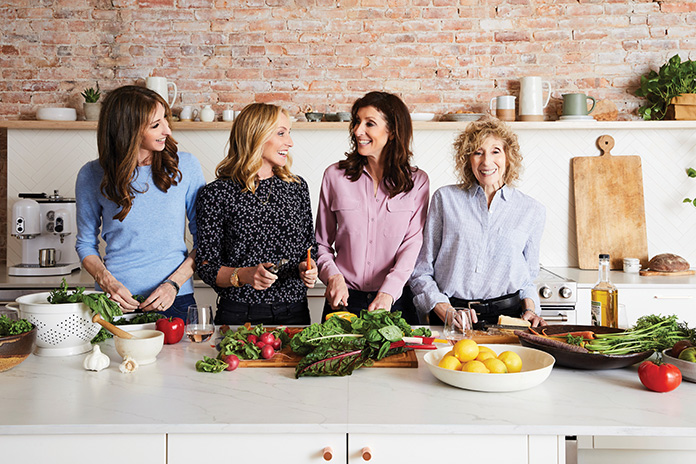Chances are you spend a lot of time thinking about what you’re going to make for dinner. But how much time do you spend thinking about the difference your dinner (or lunch or breakfast) makes—for your weight, your health and even the planet? Actress Tracy Pollan—aka Mrs. Michael J. Fox—her sisters Lori and Dana, and their mother Corky are shining a spotlight on the consequences of our food choices. Their second cookbook, Mostly Plants, features recipes for a primarily plant-based diet, with meat as an optional or occasional ingredient rather than an ever-present one.
Making plants the star of your meals might sound intimidating—until, that is, you start leafing through the cookbook and seeing dishes like shrimp scampi with zucchini noodles, and (holla!) wickedly decadent chocolate cake. In fact, as the Pollans are eager to explain, going ‘flexitarian’ isn’t so difficult after all.
What inspired the cookbook’s title?
Lori: Perhaps you know that our brother [renowned food author Michael Pollan] famously coined what they call his ‘haiku’: “Eat food, not too much, mostly plants.” And we just realized that’s the way we eat. Two of us are vegetarian, two are flexitarian. And we realized what sets our way of eating apart from other people we know, and a lot of people, is we eat a plant-based diet. The two of us who eat meat have it as sort of a side, as a flavoring, and not as their main. So fruits, vegetables, grains, legumes—and that’s where the “mostly plants” comes from.
Tracy
It’s about eating an all-inclusive diet but trying to stay as healthy and plant-based as you can, and for each person it’s very different.
What is your definition of a flexitarian?
Tracy: I was a vegetarian for many years. I started at a young age, and stayed vegetarian through my second pregnancy. I started craving meat when I was pregnant the second time, and I felt like I needed to eat it. So I started to eat it, and then became vegetarian again soon afterward. But I realized for me what worked better was I loved vegetarian food and I loved being a vegetarian, but in my life it was easier to sometimes eat meat. I have to go out socially a lot, or go to people’s houses, and I didn’t love to always have a conversation about “is there stock in the soup?” or “what is this cooked with?” I realized that it didn’t have to be all or nothing. I could be much more flexible about the way I ate. I decided that I like eating vegetables more and I’m really happy being kind of vegetarian three-quarters of the time, but when I feel like it, when I’m someplace and that’s what’s available, I don’t feel bad about not being vegetarian.
Lori: Studies have shown that vegetarians are healthier than carnivores, but flexitarians are just as healthy as their vegetarian counterparts.

Why do you think that now is the right time for a cookbook like this one?
Dana: I think for a few reasons. First, science tells us that this is the healthiest way that we can all eat. Environmentally, it’s great for the planet, and I think there’s never been a more exciting time to cook with vegetables. The options are limitless in terms of varieties of vegetables, legumes, and whole grains. There’s never been a better time than right now. In the grocery store you can get organic produce, in Walmart, in Target, I mean it’s really everywhere, and then there are farmers markets cropping up everywhere so you can get fresh-picked and seasonal produce.
What would a typical dinner look like now in your house?
Tracy: I have four children. I cook for a crowd. It’s actually hard for me when I’m only cooking for me and my husband. It’ll be like leftovers for days because I’m always just kind of over-cooking, which is great because I like to freeze things. Monday is always meatless. That’s the day we choose to go completely vegetarian. It’s usually vegetarian probably four nights a week. But, for instance, today I’m making chicken, but it’s a small amount of chicken—I’m doing a Barefoot Contessa recipe, actually—and then I’m making sautéed mushrooms and a bunch of vegetables all sautéed. So it will be like a plate of vegetables with a small piece of chicken on it. That’s sort of my classic mostly-plant meal when it’s not completely vegetarian.
How has your way of eating changed you?
Corky: I find that when I eat vegetarian meals I come away from the table feeling different. They’re lighter and they just have a different effect on me—I think more energy. A heavy meal can really make you sleepy. So just physically it makes me happier when I’ve eaten vegetarian—and I don’t all the time. But meatless Mondays go more than the one Meatless Monday in my house. I just love eating vegetarian.
Dana
When you eat mostly plants, naturally you are thinner. The research shows that vegetarians and flexitarians weigh 15 percent less than their carnivorous counterparts. So it’s a natural way to lose weight if you haven’t been eating that way.
Has it been difficult to get your spouses and children on board with a flexitarian diet?
Corky: I think if you cook a wonderful tasting dish, they’re on board.
Lori: One way I’ve been able to get people in my life on board, like my husband, is first of all [they’re] losing some weight without trying to. With my kids, I’ve always had a rule that you have to try a bite. I would find that, especially my youngest daughter who can be opinionated, she’d try a bite and she’d be like, “I’ve been missing this my whole life!”
How do you hope people use this cookbook?
Tracy: I hope they’ll use it the same way I use other cookbooks. I have kind of my go-to standard cookbooks that I can always depend on. One of them for me is our first cookbook [The Pollan Family Table]. I cook out of it all the time. I think there’s something about having that one book where you know that every recipe you try is going to be successful because it was tested and tested, and it’s going to be delicious. So I think it’s not sort of that “oh, I want to do something different,” once-in-a-blue-moon cookbook. I think this is the cookbook that is on your kitchen counter that you can open and you can use many nights a week. And you can also satisfy different dietary needs, which is really great. Because sometimes I find myself having to go to different recipes just so I satisfy everybody’s diet choices. But many of these recipes satisfy someone who’s on a gluten-free diet, someone who is vegan, someone who is vegetarian, someone who likes to have a bit of fish. There’s enough for every type of diet that I think it’s the only cookbook you’ll need right now.

Spinach, Mushroom, and Feta Cutlets
4 to 6 servings Time: 40 minutes
3 large eggs
Kosher salt
Freshly ground black pepper
3 cups finely chopped white button mushrooms, stems trimmed
4 scallions, white and light green parts, finely chopped
One 10-ounce package frozen chopped spinach, thawed and squeezed to remove excess liquid
⅔ cup plain breadcrumbs
¾ cup finely crumbled good quality feta cheese
3 tablespoons extra virgin olive oil
- Preheat the oven to 300°F.
- In a large mixing bowl, beat together the eggs, ½ teaspoon salt, and ⅛ teaspoon of pepper. Using a wooden spoon, stir in the mushrooms and scallions. Add the spinach and mix well. Gently fold in the breadcrumbs and feta cheese and stir until blended.
- Shape a handful of the mixture into a patty approximately 3-inches wide by ½-inch thick. Place the formed patty on a baking sheet or platter and repeat with the remaining mixture. (You should have 8 to 10 patties.)
- In a large nonstick skillet over medium-high heat, heat 1½ tablespoons of the oil until shimmering. Carefully place half the patties in the pan and cook undisturbed until golden brown, 3 to 4 minutes. Flip the patties and cook until the second side
is golden brown, 3 to 4 minutes more. Transfer the patties to a rimmed baking sheet and place the sheet in the oven to keep warm. Wipe the skillet clean with paper towels, add 1½ tablespoons of oil, and cook the remaining patties. - Transfer all the cutlets to a platter and serve with mango chutney.
Photographs by Nicole Frazen
From The Book MOSTLY PLANTS. CopyRright © 2019 by Old Harvest Way, LLC. Published on April 16, 2019 by Harper wave, an imprint of Harper Collins publishers.Reprinted by permission.




